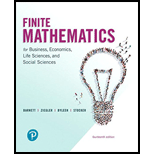
Concept explainers
Suppose that
(A) Show that
(B) Show that
Want to see the full answer?
Check out a sample textbook solution
Chapter 11 Solutions
Finite Mathematics for Business, Economics, Life Sciences and Social Sciences
Additional Math Textbook Solutions
A First Course in Probability (10th Edition)
Intro Stats, Books a la Carte Edition (5th Edition)
A Problem Solving Approach To Mathematics For Elementary School Teachers (13th Edition)
Elementary Statistics (13th Edition)
Introductory Statistics
Calculus: Early Transcendentals (2nd Edition)
- 3 Evaluate the determinants 5 17 3 0 1 2 -10-30 (a) 2 4-3 (b) -2 3 0 1 11 0 2 10-10arrow_forwardOne deck of cards is made of 4 suits (Spade, Diamond, Heart, Club) and 13 cards (A -> K), totaling 52 cards. A flush is a combination of 5 cards with the same suit. e.g. 3d 5d 9d Jd Kd A straight flush is a combination of 5 cards with the same suit, but also connected to each other. (e.g. highest straight flush is 10s Js Qs Ks As, the lowest straight flush is Ah, 2h, 3h, 4h, 5h) A straight flush is not considered a flush. Question 2 of 4 Draw random 5 cards (in one action) from the 52 cards deck, and calculate the probability of a flush. Provide the formula you used.arrow_forward2. Consider the vector force: F(x, y, z) = 2xye²i + (x²e² + y)j + (x²ye² — z)k. (A) [80%] Show that F satisfies the conditions for a conservative vector field, and find a potential function (x, y, z) for F. Remark: To find o, you must use the method explained in the lecture. (B) [20%] Use the Fundamental Theorem for Line Integrals to compute the work done by F on an object moves along any path from (0,1,2) to (2, 1, -8).arrow_forward
- Game: dropping marbles from a 100-floor tower, given unlimited amount of identical marbles. if marble breaks when dropped from level X -> it breaks from all levels higher than X if marble doesn't break when dropped from level Y -> no marbles will break when dropped from level lower than Y Goal of Game: Find the highest level, from which the marbles doesn't break. Please design a testing plan to minimize the worst-case number-of-tests required to find the answer, with the constraint you can only break max 2 marbles. What is the minimum number of tests required? Explain your testing plan and how you arrived at this number.arrow_forwardHeight = 1 Width=1 How much is the shaded area in the chart above?arrow_forward(a) Given z = x + jy determine if f (z) = z4 is analytic.(b) On an Argand Diagram sketch the region |z| < 1.(c) Map the region |z| < 1 into the function plane f (z) = U + jV , defined as f (z) = z4.arrow_forward
 Elementary Linear Algebra (MindTap Course List)AlgebraISBN:9781305658004Author:Ron LarsonPublisher:Cengage LearningAlgebra & Trigonometry with Analytic GeometryAlgebraISBN:9781133382119Author:SwokowskiPublisher:Cengage
Elementary Linear Algebra (MindTap Course List)AlgebraISBN:9781305658004Author:Ron LarsonPublisher:Cengage LearningAlgebra & Trigonometry with Analytic GeometryAlgebraISBN:9781133382119Author:SwokowskiPublisher:Cengage College AlgebraAlgebraISBN:9781305115545Author:James Stewart, Lothar Redlin, Saleem WatsonPublisher:Cengage Learning
College AlgebraAlgebraISBN:9781305115545Author:James Stewart, Lothar Redlin, Saleem WatsonPublisher:Cengage Learning Algebra and Trigonometry (MindTap Course List)AlgebraISBN:9781305071742Author:James Stewart, Lothar Redlin, Saleem WatsonPublisher:Cengage Learning
Algebra and Trigonometry (MindTap Course List)AlgebraISBN:9781305071742Author:James Stewart, Lothar Redlin, Saleem WatsonPublisher:Cengage Learning
 Linear Algebra: A Modern IntroductionAlgebraISBN:9781285463247Author:David PoolePublisher:Cengage Learning
Linear Algebra: A Modern IntroductionAlgebraISBN:9781285463247Author:David PoolePublisher:Cengage Learning





